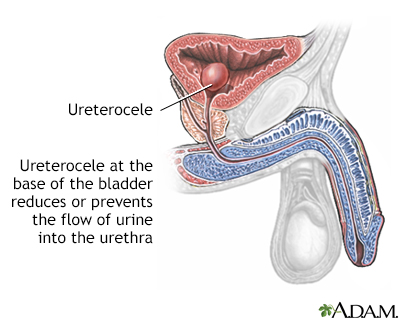Pregnancy SmartSiteTM
Incontinence - ureterocele DefinitionA ureterocele is a swelling at the bottom of one of the ureters. Ureters are the tubes that carry urine from the kidney to the bladder. The swollen area can block urine flow. A ureterocele is a birth defect. CausesA ureterocele occurs in the lower part of the ureter. It is the part where the tube enters the bladder. The swollen area prevents urine from moving freely into the bladder. The urine collects in the ureterocele and stretches its walls. It expands like a water balloon. A ureterocele can also cause urine to flow backward from the bladder to the kidney. This is called reflux. Ureteroceles occur in about 1 in 500 people. This condition is equally common in both the left and right ureters. SymptomsMost people with ureteroceles do not have any symptoms. When symptoms do occur, they may include:
Some other symptoms are:
Exams and TestsLarge ureteroceles are often diagnosed earlier than smaller ones. It may be discovered in a pregnancy-related ultrasound before the baby is born. Some people with ureteroceles do not know they have the condition. Often, the problem is found later in life due to kidney stones or infection. A urinalysis may reveal blood in the urine or signs of urinary tract infection. The following tests may be done:
Blood pressure may be high if there is kidney damage. TreatmentAntibiotics are often given to prevent further infections until surgery can be done. The goal of treatment is to eliminate the blockage. Drains placed in the ureter or renal area (stents) may provide short-term relief of symptoms. Surgery to repair the ureterocele cures the condition in most cases. Your surgeon may cut into the ureterocele. Another surgery may involve removing the ureterocele and reattaching the ureter to the bladder. The type of surgery depends on your age, overall health, and extent of the blockage. Outlook (Prognosis)The outcome varies. The damage may be temporary if the blockage can be cured. However, damage to the kidney may be permanent if the condition doesn't go away. Kidney failure is uncommon. The other kidney will most often work normally. Possible ComplicationsComplications may include:
When to Contact a Medical ProfessionalContact your health care provider if you have symptoms of ureterocele. ReferencesGuay-Woodford LM. Hereditary nephropathies and developmental abnormalities of the urinary tract. In: Goldman L, Schafer AI, eds. Goldman-Cecil Medicine. 26th ed. Philadelphia, PA: Elsevier; 2020:chap 119. Stanasel I, Peters CA. Ectopic ureter, ureterocele, and ureteral anomalies. In: Partin AW, Dmochowski RR, Kavoussi LR, Peters CA, eds. Campbell-Walsh-Wein Urology. 12th ed. Philadelphia, PA: Elsevier; 2021:chap 41. | |
| |
Review Date: 7/4/2022 Reviewed By: Kelly L. Stratton, MD, FACS, Associate Professor, Department of Urology, University of Oklahoma Health Sciences Center, Oklahoma City, OK. Also reviewed by David C. Dugdale, MD, Medical Director, Brenda Conaway, Editorial Director, and the A.D.A.M. Editorial team. The information provided herein should not be used during any medical emergency or for the diagnosis or treatment of any medical condition. A licensed medical professional should be consulted for diagnosis and treatment of any and all medical conditions. Links to other sites are provided for information only -- they do not constitute endorsements of those other sites. No warranty of any kind, either expressed or implied, is made as to the accuracy, reliability, timeliness, or correctness of any translations made by a third-party service of the information provided herein into any other language. © 1997- A.D.A.M., a business unit of Ebix, Inc. Any duplication or distribution of the information contained herein is strictly prohibited. | |

 Female urinary tra...
Female urinary tra... Male urinary tract
Male urinary tract Ureterocele
Ureterocele
